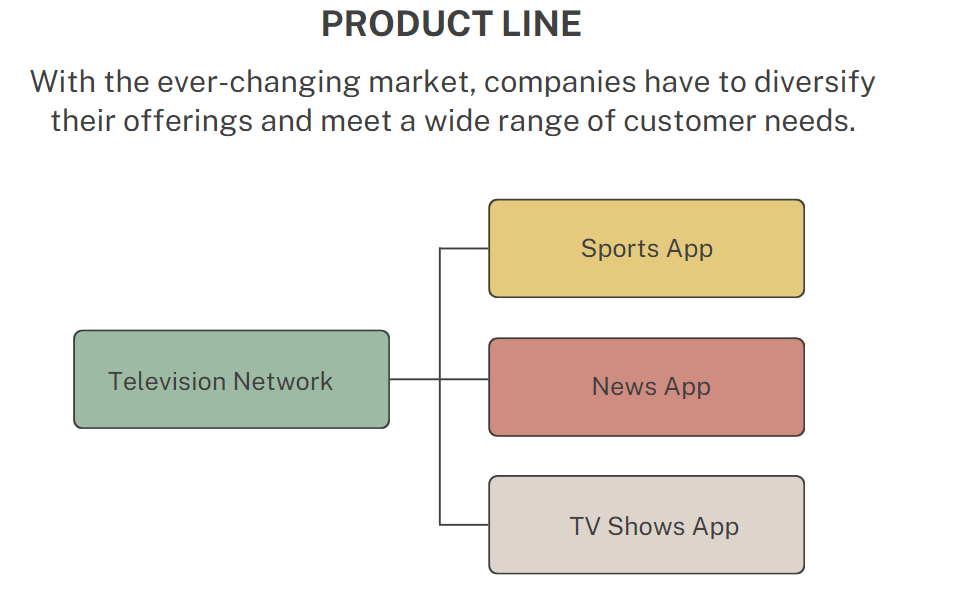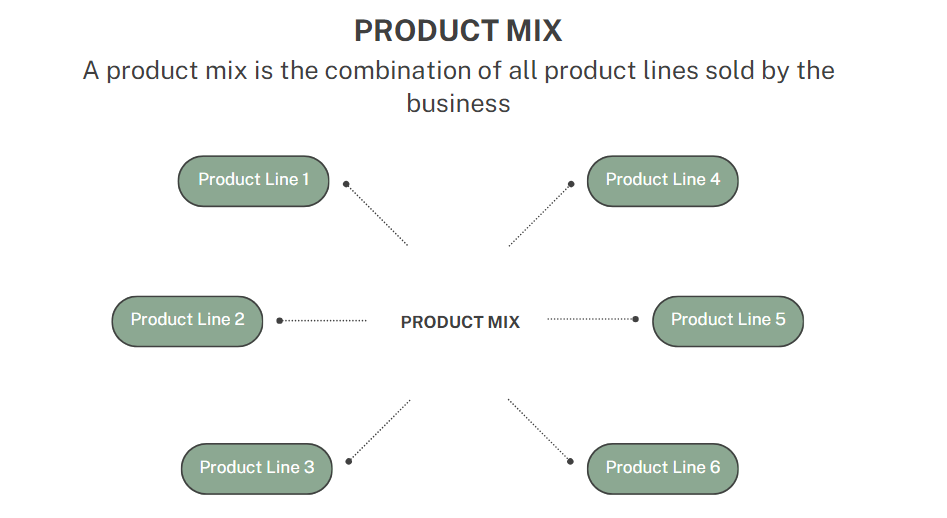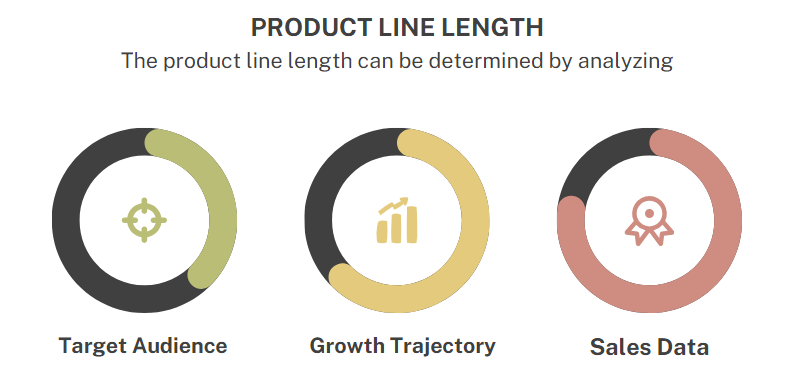Editor’s note: This article was reviewed and updated on 9 October 2024 to provide more information about the benefits of product lines, examples of product lines, and the differences between a product line manager and a product manager.

A product line is a group of related products sold by a company under a single brand. A company might have multiple brand names for different product lines, like PepsiCo’s Pepsi brand for soft drinks and FritoLay brand for snack foods.
The concept of a product line serves as a strategic approach to market segmentation by allowing a business to diversify its offerings and enhance customer appeal. If customers are already familiar with a brand or company, they’re more likely to try other products from that brand.
Besides that, product lines allow you to target different consumer segments with precision and also play a crucial role in defining your identity and competitive edge in the marketplace. For example, a product line could be determined by factors like customer needs, price range, and market trends or opportunities.
Some product lines you might be familiar with are:
The products grouped within a product line often share characteristics like functionality or design, allowing them to meet related customer needs within the same market segment.
In this article, you’ll learn what a product line is, the different types of them, and how to analyze them.
A product line is a collection of products that are advertised and marketed under a single brand. Each product in a product line can serve different purposes or target specific customer preferences. The benefits of this approach include:
A common example is Microsoft. It offers XBOX, Windows, and multiple other products. Its shared goal is to maintain its place in the technology consumer market.
Product line management is a specific subset of product management. A product manager might focus on one or more products that aren’t necessarily related, whereas a product line manager oversees a group of multiple, related products.
A product line manager will likely have many of the same responsibilities as a product manager, such as conducting market research, creating a product development strategy, and managing the product lifecycle. Responsibilities specific to product line management might include determining a product line strategy, managing product line length, and performing product line analysis.
The concept of product lines isn’t just theoretical; it’s a proven practical strategy embraced by many leading software companies. With the ever-changing market, companies have to diversify their offerings and meet a wide range of customer needs:

Here are a few examples of effective product lines in the tech industry.
Adobe’s Creative Cloud is a prime example of a product line done right. It’s designed for creators in various fields. Adobe included a range of software like Photoshop for image editing, Illustrator for vector graphics, Premiere Pro for video editing, and many more.
Each product targets a different aspect of digital creativity, yet all are integrated under the Creative Cloud platform. It provides a seamless experience under a unified subscription model.
Google has evolved from the days of being just a search engine. It now includes a whole package of tools catering to diverse needs. Many consumers now prefer Google’s suite over Microsoft Office and that’s a big achievement.
The product line strategy has helped these tech giants develop related products under a single brand. This has not only expanded market presence but also built strong brand loyalty among users.
Product lines can be categorized into three main types. Each type has its unique characteristics and strategic focus. The choice of a category depends on the business.
As a PM, you can directly input how the brand tailors its offerings for an effective expansion. Here’s an overview of each type:
Each type of product line serves a different purpose and requires a distinct approach to marketing. For instance, staple product lines ensure a steady flow of revenue and customer retention.
On the other hand, seasonal lines capitalize on peak demand periods. Lastly, specialty lines build brand prestige and cater to specific consumer segments.
The process of deciding on a product line requires careful planning and research. As a product manager, you will need to dive deep into market and consumer research.
You have to ensure the chosen product line not only meets the current market demand, but also anticipates future trends and preferences. It takes a considerable effort to determine the correct product line for your brand.
The following considerations serve as a good starting point:
Using this framework, you can develop a product line that aligns with your long-term goals and capabilities.
A common misunderstanding for product managers is the difference between product lines and product mix.
A product line focuses on depth within a specific category of offerings. On the other hand, the product mix spans the breadth of everything a company has to offer. It is the collection of all the product lines:

Product line length refers to the number of products within a product line. Managing product line length is about finding the right balance. If you have too few products, it might lead to missed opportunities. But if you have too many, it dilutes the brand value and confuses customers.
Some key considerations can help you find the right balance:

Regular assessment is needed as the business grows and the product line evolves. It ensures the product line remains efficient, relevant, and capable of growth.
As a PM, understanding the performance and potential of a product line is crucial. Several methods can help in this analysis. Each method offers a unique insight into how a product line is performing and where there might be room for improvement.
This method involves looking at the sales data of each product within the line. It helps identify which products are performing well and which are lagging. By using this method, you get a clear picture of customer preferences and market trends.
Here, you compare your product line’s market share to that of competitors. It helps you gather insights about your position in the market. Understanding the competitive landscape can be challenging, but this method makes it simpler.
This information can guide product development, marketing strategies, and customer service improvements.
Examining the profit margins of products within the line can highlight items that are contributing the most. This analysis is key for focusing efforts on the most profitable products.
The market is always evolving and it can be hard to keep up with the diversity of needs. Product lines aim to make it more approachable without compromising brand identity.
As a product manager, you’ll have direct input on key decisions related to the product offerings of your brand.
The following takeaways are worth noting:
Product lines are more than just a collection of products. They are a reflection of a company’s strategic vision and market positioning. Having a solid product line can help you gain an edge in the market and expand your consumer base.
Featured image source: IconScout

LogRocket identifies friction points in the user experience so you can make informed decisions about product and design changes that must happen to hit your goals.
With LogRocket, you can understand the scope of the issues affecting your product and prioritize the changes that need to be made. LogRocket simplifies workflows by allowing Engineering, Product, UX, and Design teams to work from the same data as you, eliminating any confusion about what needs to be done.
Get your teams on the same page — try LogRocket today.

A practical guide for PMs who want to stop being bottlenecks, delegate smarter, and lead teams effectively with a clear ownership framework.

Stop letting unreliable data block features. Treat data as inventory to track quality, ownership, and ship with confidence.

Learn why slide decks slow teams down and explore better tools like whiteboards, PRDs, and prototypes to improve collaboration and alignment.

AI PM roles are evolving fast. Learn the five types of AI PMs, the skills they need, and how they shape AI products across industries.